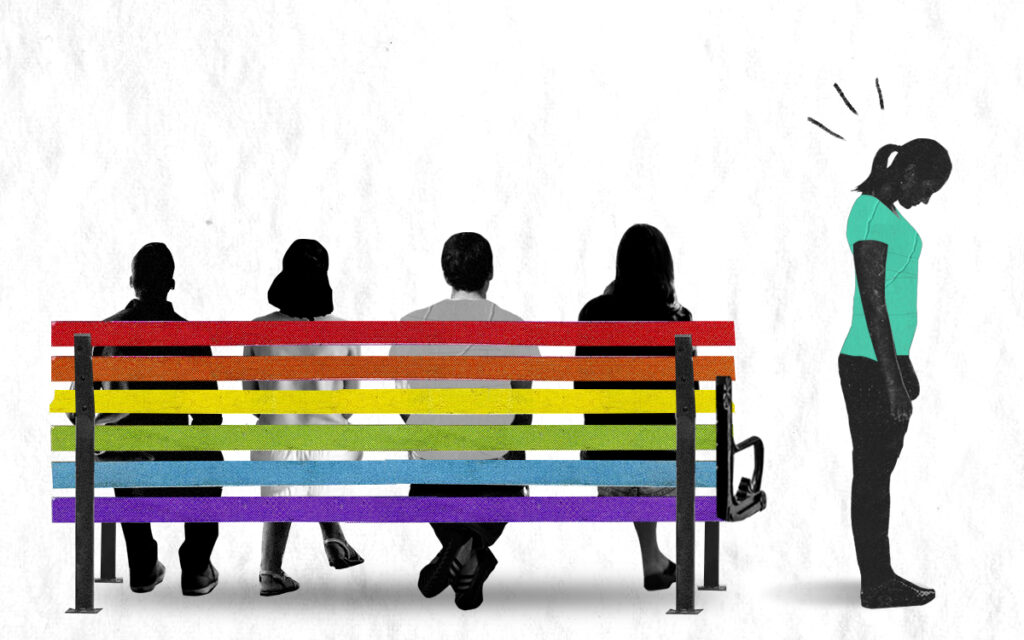In today’s society, sexuality is a complex and diverse aspect of human life. While some individuals may experience heightened sexual desires and behaviors, others may identify as asexual, lacking sexual attraction altogether. The contrasting experiences of hypersexuality and asexuality raise questions and create a space for understanding the diverse range of human sexuality. This article aims to shed light on hypersexual and asexual as two ends of the spectrum, exploring their definitions, causes, challenges, and coping strategies.
Contents
Understanding Hypersexuality

Hypersexuality, also known as compulsive sexual behavior or sex addiction, refers to an intense and excessive preoccupation with sexual thoughts, fantasies, or activities. Individuals experiencing hypersexuality may engage in frequent sexual encounters, have a heightened sex drive, and struggle to control their impulses. It is important to note that hypersexuality should not be confused with a high libido, as it represents a condition that significantly interferes with one’s daily functioning and well-being.
Causes of Hypersexuality
The causes of hypersexuality can vary and may be influenced by a combination of biological, psychological, and environmental factors. Some potential causes include:
- Biological Factors: Certain medical conditions, such as bipolar disorder, dementia, or brain tumors, can contribute to the development of hypersexuality. Additionally, imbalances in neurotransmitters like dopamine may play a role.
- Psychological Factors: Past trauma, childhood abuse, or emotional distress can contribute to the development of hypersexual behaviors as a coping mechanism.
- Environmental Factors: Social and cultural factors, exposure to explicit or provocative media, or a history of sexual abuse can impact the development of hypersexuality.
Symptoms and Behaviors Associated with Hypersexuality
Some common signs and symptoms of hypersexuality may include:
- Frequent sexual fantasies or urges: Individuals with hypersexuality often experience persistent and intrusive sexual thoughts or desires that are difficult to control.
- Compulsive sexual behaviors: This may involve excessive masturbation, frequent casual or risky sexual encounters, excessive pornography consumption, or engaging in multiple sexual relationships simultaneously.
- Preoccupation with sex: Hypersexual individuals may spend a significant amount of time thinking about sex, seeking sexual opportunities, or planning sexual encounters.
- Impaired impulse control: People with hypersexuality often struggle with controlling their sexual impulses, leading to engaging in sexual behaviors even when they have negative consequences.
- Negative impact on daily life: Hypersexuality can interfere with personal relationships, work, or other areas of life. It may lead to relationship conflicts, financial problems, legal issues, or a decline in work or academic performance.
It’s worth mentioning that having a high sex drive or engaging in consensual sexual activities frequently does not necessarily indicate hypersexuality. Hypersexuality becomes a concern when it causes distress, impairs functioning, or results in harm to oneself or others.
About Asexuality
Asexuality is a sexual orientation characterized by a lack of sexual attraction or desire toward others. Asexual individuals may experience romantic attraction, emotional connections, and deep relationships without experiencing sexual attraction. It is important to understand that asexuality is not a disorder or a medical condition but rather a valid and diverse sexual orientation.
Symptoms and Behaviors Associated with Asexuality

- Lack of sexual attraction: Asexual individuals typically do not experience sexual attraction to others. They may not find others sexually appealing or desire sexual relationships or experiences.
- Emotional connection: Asexual individuals may prioritize emotional intimacy, such as forming deep connections, building trust, and fostering non-sexual relationships, over sexual interactions.
- Limited sexual fantasies or thoughts: Asexual individuals generally have fewer sexual fantasies or thoughts compared to individuals who experience sexual attraction. Their focus and interests may lie elsewhere.
- Disinterest or aversion to sexual activities: Asexual individuals may have little to no interest in engaging in sexual activities. They may find the idea of sex unappealing or uncomfortable.
- Variability in romantic attraction: Asexuality does not necessarily indicate a lack of romantic attraction. Asexual individuals can experience romantic attraction and engage in romantic relationships without a strong sexual component. T
- Individual differences: Asexuality is a diverse spectrum, and individuals within the asexual community may have different experiences and preferences. Some may experience a complete absence of sexual attraction, while others may experience occasional or limited attraction.
Differentiating Asexuality from Hypersexuality
While hypersexuality involves excessive sexual thoughts and behaviors, asexuality represents a lack of sexual attraction. These two experiences exist at opposite ends of the sexual spectrum.
It is essential to recognize that asexuality is not a dysfunction or a problem that requires fixing. Instead, it is a natural and valid orientation for those who identify as asexual.
It is important to note that asexuality and hypersexuality are not mutually exclusive, and individuals can identify with other sexual orientations while also experiencing hypersexuality. Moreover, it is possible for someone to experience fluctuations in their sexual desire and behaviors over time, regardless of their sexual orientation.
If you or someone you know is struggling with issues related to sexual orientation, sexual behaviors, or concerns about sexual health, it is recommended to seek guidance from a qualified mental health professional or a healthcare provider. They can provide appropriate support, assessment, and personalized recommendations based on individual circumstances.
Challenges Faced by Hypersexual and Asexual Individuals
Both hypersexual and asexual individuals face unique challenges that can impact their well-being, relationships, and self-acceptance. Understanding these challenges is crucial in creating a more inclusive society.
Stigma and Misunderstanding
Hypersexual individuals often face stigma and judgment due to societal norms and misconceptions. They may be labeled as promiscuous or morally flawed, leading to feelings of isolation and shame. On the other hand, asexual individuals may also encounter misunderstanding and invalidation of their experiences, with their orientation being dismissed or pathologized.
Relationships and Intimacy
Navigating relationships can be challenging for both hypersexual and asexual individuals. Hypersexuality can strain relationships due to difficulties maintaining monogamy, leading to conflicts and feelings of betrayal. Asexual individuals may face challenges in finding compatible partners who understand and respect their lack of sexual attraction, which can lead to feelings of loneliness or exclusion.
Self-acceptance and Identity
Both hypersexuality and asexuality can impact an individual’s self-perception and identity. Hypersexual individuals may struggle with feelings of shame or guilt, questioning their behaviors and seeking acceptance. Asexual individuals may grapple with societal pressures and expectations, questioning their own experiences and seeking validation.
Coping Strategies and Support

Finding effective coping strategies and support systems can greatly benefit individuals navigating hypersexuality or asexuality.
- Self-Care Practices: Engaging in self-care activities can help promote overall well-being and resilience. This can include activities such as practicing mindfulness, engaging in hobbies, spending time in nature, exercising regularly, getting enough sleep, and maintaining a healthy diet.
- Therapy or Counseling: Seeking the support of a mental health professional, such as a therapist or counselor, can provide a safe space to explore and address personal challenges. They can offer guidance, coping strategies, and tools to navigate difficult emotions, thoughts, or behaviors.
- Social Support: Connecting with understanding and empathetic individuals, whether it’s family, friends, or support groups, can provide emotional support and a sense of belonging. Sharing experiences, and concerns, and seeking advice from others who have gone through similar situations can be comforting.
- Education and Information: Gathering knowledge about one’s challenges or condition can be empowering. Learning about the experiences of others, reading books, attending workshops, or accessing reputable online resources can help individuals better understand themselves and find strategies to cope effectively.
- Mindfulness and Relaxation Techniques: Practicing techniques like deep breathing exercises, meditation, yoga, or progressive muscle relaxation can help manage stress and anxiety, and promote a sense of calm.
- Journaling and Expressive Writing: Writing down thoughts, feelings, and experiences in a journal can serve as an outlet for self-reflection, emotional processing, and gaining insights into one’s patterns and triggers.
- Spiritual or Faith-based Practices: Engaging in spiritual or faith-based practices, such as prayer, meditation, or attending religious services, can provide comfort, guidance, and a sense of purpose for some individuals.
Conclusion
Recognizing and understanding the diverse range of human sexuality is essential for creating an inclusive society. Hypersexuality and asexuality represent two contrasting experiences on this spectrum, each with its unique challenges and coping strategies. By promoting education, empathy, and support, we can foster acceptance and celebrate the diversity of human sexual orientations.
Life may sometimes be challenging for asexuals, but Online Asexual Counseling can help. Get experienced LGBTQ therapists at PrideMantra: Book a trial LGBTQ therapy session.


